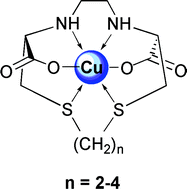Synthesis and characterization of the copper(ii) complexes of new N2S2-donor macrocyclic ligands: synthesis and in vivo evaluation of the 64Cu complexes†
Abstract
The aim of this work was to prepare a novel class of 64Cu(II) labeled complexes with the new macrocyclic ligands 1,10-dithia-4,7-diazacyclododecane-3,8-dicarboxylic acid (NEC-SE, 1), 1,10-dithia-4,7-diazacyclotridecane-3,8-dicarboxylic acid (NEC-SP, 2) and 1,10-dithia-4,7-diazacyclotetradecane-3,8-dicarboxylic acid, (NEC-SB, 3) to evaluate the usefulness of these macrocycles for potential utility as 64Cu(II) chelators. The corresponding non-radioactive complexes [Cu(NEC-SE)]·3H2O (4), [Cu(NEC-SP)]·3H2O (5) and [Cu(NEC-SB)] (6) were prepared and their 64Cu-analogs, [64Cu(NEC-SE)] (7) and [64Cu(NEC-SP)] (8) and [64Cu(NEC-SB)] (9) were produced in >98% radiochemical purity. Rats were injected with complex 7, 8 or 9 and were euthanized at 1, 4 and 24 h. All three complexes are cleared from the blood over the first hour following injection but there is poor clearance of this activity over 24 h. A similar pattern of retention was noted in the liver where the levels of activity in this tissue at 1 h are not statistically different from those at 24 h. Molecular mechanics and DFT studies were performed on the complexes in order to gain insight into the lower stability.


 Please wait while we load your content...
Please wait while we load your content...